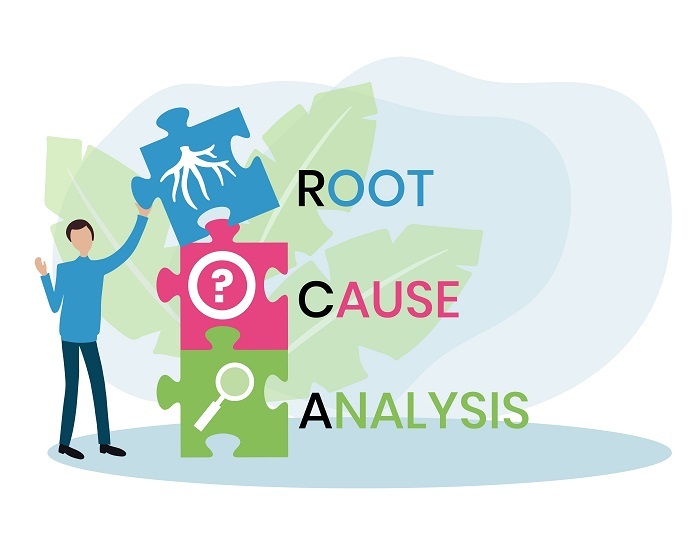
 Data Structure
Data Structure Networking
Networking RDBMS
RDBMS Operating System
Operating System Java
Java MS Excel
MS Excel iOS
iOS HTML
HTML CSS
CSS Android
Android Python
Python C Programming
C Programming C++
C++ C#
C# MongoDB
MongoDB MySQL
MySQL Javascript
Javascript PHP
PHPPhysics
Chemistry
Biology
Mathematics
English
Economics
Psychology
Social Studies
Fashion Studies
Legal Studies
- Selected Reading
- UPSC IAS Exams Notes
- Developer's Best Practices
- Questions and Answers
- Effective Resume Writing
- HR Interview Questions
- Computer Glossary
- Who is Who
Techniques for Identifying and Addressing Root Causes of Quality Problems
Quality issues may be damaging to a company or organization's performance. That may result in diminished consumer satisfaction, lost revenue, and reputational harm. Identifying the source of quality issues is essential before you can implement effective remedies to prevent similar issues. This blog will go through numerous methods for identifying and resolving the underlying causes of quality issues.
Let's talk about how to collaboratively identify problems, identify probable root causes of problems, and decide what steps to follow to confirm and validate fundamental causes and promote efficient issue solutions. This strategy may address a single problem or a persistent issue that can no longer be disregarded.

What is Root Cause Analysis?
Root Cause Analysis (RCA) is an acclaimed and often-used method that aids in determining the root cause of an issue. It aims to locate the fundamental cause of an issue using a specified set of procedures and accompanying tools, allowing you to understand what happened, why it occurred, and what to do to lessen the risk of it occurring again.
RCA presupposes a relationship between systems and events. The effects of one action ripple out to affect others, and so on. You may determine the source of the issue, and how it evolved into the symptom you're now experiencing by tracking back these steps.
How to Identify Quality Problems?
Use Data
Data must be gathered and analyzed to pinpoint the underlying reason for a quality issue. Data analysis aids in the discovery of trends and patterns that might assist in pinpointing the root cause of a problem. Pareto analysis, for instance, may assist in identifying where issues occur most often, enabling firms to concentrate their resources on the most important areas of concern.
Ask Questions
Asking questions is a good technique for identifying a problem's underlying causes. The 5 Whys methodology repeatedly asks "why" until the issue's root is found. This method promotes a thorough investigation of the problem, which helps identify its underlying causes.
Engage Stakeholders
Involving teams, including staff members, clients, suppliers, and other partners, may provide insight into the quality issue. Stakeholders may have viewpoints and experiences that may be used to determine the problem's underlying causes. Businesses may get a deeper knowledge of the problem and find solutions that may not have been immediately obvious by incorporating stakeholders.
Use a Team Strategy
The issue may be fully understood by assembling a cross-functional team with individuals from several departments and fields of expertise. Businesses may find the problem's underlying causes and create workable solutions using different team members' knowledge.
Assess the Process
Studying the process enables the location and mode of the quality issue to be determined. Businesses may find modifications or deviations from the usual procedure that may contribute to the issue by evaluating the process phases. By identifying these problem areas, changes that tackle the underlying causes of the issue may be made.
Employ a Structured Approach
A step-by-step process for identifying and resolving the root cause of a quality issue is provided by using a structured problem-solving technique, such as DMAIC or PDCA. These methods provide a framework for data analysis, the discovery of probable causes, the testing of remedies, and the implementation of changes.
Test Your Assumptions
Recognizing biases and assumptions causing the quality issue is critical. Testing these hypotheses ensures that companies aren't making wrong conclusions or using inefficient remedies. Businesses may ensure they correctly identify the problem's fundamental cause and implement effective remedies by testing their hypotheses.
Techniques for Root Cause Analysis of Quality Problems
1. 5 Ways
The 5 Whys is a problem-solving method that includes asking "why" five times to identify the source of an issue. Sakichi Toyoda created the method of the company's founder to find the source of production flaws and quality problems.
The method asks "why" five times in succession, with each response prompting a further "why" inquiry until the problem's underlying cause is found. The strategy works to identify the root of the issue rather than merely its symptoms by asking "why" repeatedly.
The 5 Whys strategy offers a planned and methodical problem-solving approach, making it helpful. It fosters a thorough dive into the issue and helps to uncover the main cause rather than merely treating the symptoms. This may result in better solutions that deal with the underlying problem rather than merely covering it up.
2. Fishbone Diagram
The Fishbone diagram called the Ishikawa diagram or a cause-and-effect diagram, is a method for locating a problem's underlying causes. The issue or effect is at the head of the fish, and the causes branch off the spine, giving the figure the appearance of a fishbone.
It offers a visual picture of the issue and its possible causes, making it simpler to comprehend how they are related. Due to this, teams may be able to find connections and patterns that weren't originally obvious.
Also, the Fishbone diagram promotes teamwork and brainstorming, enabling team members from other areas to share their knowledge and ideas. This may result in a deeper comprehension of the issue and its possible causes. It helps to prioritize probable causes by dividing them into primary categories, making concentrating on the most crucial areas for change simpler.
3. Pareto Analysis
Pareto Analysis is a problem-solving approach that assists in identifying and prioritizing the most relevant causes of an issue. Its foundation is the Pareto principle, which holds that only 20% of cases result in 80% of the outcomes.
Data on the many causes of the issue are gathered, and the reasons are then sorted according to frequency or effect to do a Pareto analysis. This aids in identifying both the "trivial many" factors that have little effect and the "essential few" ones that account for the bulk of the issue.
Since it aids in concentrating problem-solving efforts on the most crucial root causes of the issue, the Pareto Analysis is helpful. Businesses may significantly improve quality, save expenses, and boost customer happiness by focusing on a few critical factors.
4. Failure Mode and Effects Analysis
FMEA is a risk management method that assists in locating and assessing any flaws or faults in a procedure or product. It is a methodical and proactive strategy that seeks to thwart issues before they arise rather than only responding to them after the fact.
Each possible failure mode is identified and examined as part of the FMEA process to determine its chance of happening, the severity of its effects, and its detectability. The possible failure modes are then prioritized using this knowledge, and effective measures to stop or lessen their occurrence are subsequently developed.
Let's take the case of a business creating a new product. The business may identify possible failure modes, such as design faults or manufacturing errors, and create suitable steps to stop or lessen their occurrence by doing an FMEA. This may enhance product quality while lowering the possibility of expensive recalls or unsatisfied customers.
Conclusion
Root cause analysis is a great method for identifying the source of a problem. The root cause of success may also be determined via RCA, normally used to diagnose issues. Whether you choose one of these strategies or mix components to create your strategy, the fundamental principle remains the same. The only approach to solving an issue permanently and preventing recurrence is to identify its underlying cause. Your continuous improvement culture and outcomes will flourish when your team has the knowledge and abilities to explore beyond the obvious.

